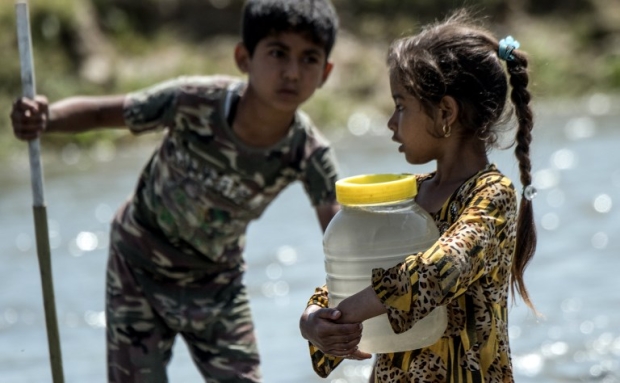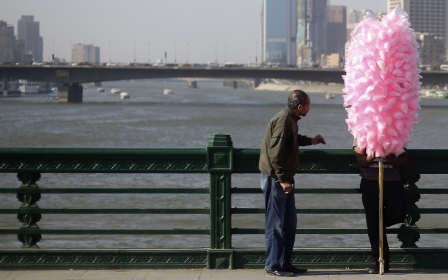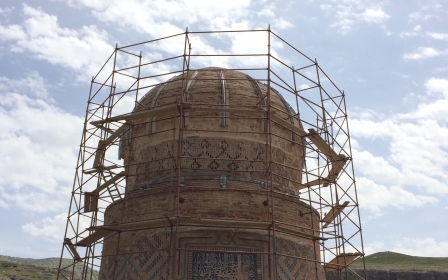Before the flood: Turkey's new dam set to wash away past despite uncertain future

Editor’s note: Two of the biggest dam projects in the world – one in Turkey, the other in Ethiopia – are nearing completion. Both are likely to profoundly affect the lives of millions in the Middle East and bring further tensions to already severely water-stressed regions.
In the first of two reports, environment journalist Kieran Cooke investigates the giant Ilisu dam on the Tigris river in southeastern Turkey.
Thousands of people will be displaced and have their livelihoods threatened. Some of the world’s most precious archaeological treasures will be lost forever. In Iraq, already dire water shortage problems are set to become even worse.
After years of delays and rumoured large cost overruns, within the next few months engineers will carry out final work on the Ilisu dam in southeastern Turkey, a short distance from the country’s southern border with Iraq and Syria, and start filling a 400km-long reservoir stretching back along the Tigris river.
Both locals, mainly Kurdish citizens of Turkey, and those living across the border, particularly in Iraq, are anxiously watching and waiting.
The 1,200 MW Ilisu dam, almost two kilometres wide and 130 metres high, is a centrepiece of what’s known in Turkish as Geneydogu Anadolu Projesi (GAP), or the Southeastern Anatolia Project.
Ankara says the dam is vital in order to bring development to one of Turkey’s poorest regions; it will supply power to homes, agriculture and industry and create thousands of much-needed jobs.
In a statement, the Turkish foreign ministry also says it will have environmental benefits by increasing supplies of clean energy and putting a halt to substantial quantities of greenhouse gas emissions.
And it says that campaigners have exaggerated the number of villages and residents that will be affected by the project.
Turkish officials have also sought to address concerns about the impact of the dam on Iraq's water supplies.
In June and October this year, officials said that plans to start filling the reservoir had been delayed in response to Iraqi concerns.
But many still have major concerns.
“The whole scheme is such a disaster, so terrible,” Ulrich Eichelmann, the CEO of Riverwatch, a Vienna-based NGO which for many years has been part of an international campaign opposing the Ilisu project, told Middle East Eye.
“In southeastern Turkey it will submerge thousands of years of history and in Iraq it threatens areas like the marshes in the south of the country, one of the greatest cultural and ecological sites on earth.
“To think this is happening in the 21st century is unbelievable.”
Ancient sites underwater
The town of Hasankeyf, about 80 kilometres upriver from the Ilisu dam, is 12,000 years old and one of the most ancient, continually inhabited settlements on the globe, once a staging post on the famed Silk Road.
When the dam’s reservoir is filled, much of Hasankeyf, along with some of its ancient monuments and Neolithic caves carved out of the banks of the Tigris, will be submerged under more than 30 metres of water.
Other villages and settlements along the river are likely to disappear.
Hasankeyf’s 3,000 inhabitants are being told to relocate to new houses being built above the existing town. Many locals have objected, saying not only their homes but incomes dependent on tourism are set to disappear.
“People that don’t have a past cannot determine their future,” a local member of the Save Hasankeyf Initiative campaigning group told DW, the German broadcaster, last year.
“They are not only destroying our past but also our future by taking away this as a source of income and heritage.”
The Turkish authorities disagree, saying the reservoir will bring new tourists to the area, among them scuba divers eager to explore submerged ruins.
They have also relocated several historic buildings and monuments. Earlier this month, works began to relocate the final section of the 600-year old Eyyubi Mosque to a new Hasankeyf cultural park above the waterline.
John MacGinnis, an archaeologist based at the British Museum in London, was part of an international team that worked for many years on an archaeological dig at Ziyaret Tepe, about 160 kilometres upstream from the Ilisu dam.
'From an archaeological point of view what’s happening is a disaster'
- John MacGinnis, archaeologist
Most of the Ziyaret Tepe site, once known as Tushan, will be flooded when Ilisu’s reservoir is filled.
In ancient times – 2,800 years ago - the settlement was a provincial capital of the Assyrian empire, a kingdom centred on the so called ‘Fertile Crescent’ between the Tigris and Euphrates rivers and, in its day, the greatest empire the world had ever seen.
“This whole area forms part of a region where civilisation was first established and there are so many sites to be investigated and so much material to be analysed and unearthed” says MacGinnis.
“The trouble is that much of the Assyrian building work was of clay and mud – that won’t survive under water and will be lost forever.
“From an archaeological point of view what’s happening is a disaster.”
Currency crisis
The area around Ilisu and its reservoir has become increasingly militarised, with allegations that the government is intent on using the dam in order to exert greater control over the local, mainly Kurdish, population.
President Recep Tayyip Erdogan has in the past accused opponents of dam projects of supporting the banned Kurdistan Workers Party (PKK), which Turkey considers a terrorist organisation.
Ever since work began on the Ilisu scheme back in 2006, it has also been dogged by controversy and considerable delays.
Overseas governments refused export credits; in 2009 foreign companies withdrew from the project due to Turkey’s failure to meet various environmental and other contractual criteria and pressure from local and international NGOs.
With foreign banks refusing to back the scheme, Turkish banks have been pressured by the government to provide funding.
A crisis earlier this year in the Turkish financial market, with the value of the lira plummeting, caused delays and cost overruns to a number of giant, prestige projects undertaken by the Erdogan administration.
The cost of the Ilisu dam is officially put at $1.5 billion though observers say the final bill could be substantially higher; critics complain that the financing of the project and the way various contracts have been awarded has not been transparent.
'Hydro-hegemon'
Earlier this year, in the midst of the worst drought experienced in Iraq for 80 years, water levels on the Tigris in Iraq, downstream from the Ilisu dam, sunk to record lows.
For the first time in living memory, people in Baghdad found they could wade across the river. Water levels on the Euphrates also dropped dramatically.
A severe water crisis developed with agriculture in the south of Iraq particularly badly hit.
Together the Tigris and Euphrates supply more than 90 percent of Iraq’s water. Both rivers have grown increasingly polluted as pesticides and fertilisers used on irrigation projects both in Turkey and Iraq have flowed back into the river system.
Iraq was quick to blame Turkey for its summer water woes.
Academics writing about trans-boundary water conflicts meanwhile have used Turkey as an example of a "hydro-hegemon", citing the GAP project as a "prime example" of "large infrastructure enabling the capture of resources and significantly altering the nature of the competition over water to the advantage of the constructor".
Turkish officials however have stressed that they aim to ensure that the water is shared in an "equitable, reasonably and optimal" manner.
They also argue that the dam will allow the flow of water to be managed and controlled in a way that ensures it benefits both Turkey and its neighbours.
In the summer, Turkish officials said the government had agreed to delay filling the Ilisu dam in response to Iraqi concerns.
Fatih Yildiz, Ankara's ambassador in Baghdad, said the decision had been taken by Erdogan himself.
“As of this moment, Tigris waters are being transferred to Iraq without touching a drop of it in Ilisu,” Yildiz wrote on Twitter.
But hydrologists point out this was in many ways an empty gesture; in the summer months, when the announcement was made, there is little water available for filling.
Turkey is only likely to start its operations at Ilisu following the snow melt in the headwaters of the Tigris in springtime in the early months of the year.
Not all blame for the Iraqi drought and the catastrophically low levels of water in the Tigris can be attributed to the Ilisu dam.
Iran has also been building a number of dams on tributaries which flow into the Tigris, diverting water for its own agricultural schemes.
Iraq is particularly concerned about the construction in Iran of the large-scale Daryan dam.
Iraq has been in a state of war or under crippling economic sanctions for much of the last 30 years. It is still recovering after seeing about a third of its territory, including the Mosul dam, overrun in 2014 by Islamic State group militants, who have been in retreat since last year but continue to pose a threat to security.
Much of its infrastructure, including water systems, has been destroyed. Corruption and chronic mismanagement have also contributed to water shortages.
Climate change could make dams redundant
In the background is the prospect of climate change, with the whole region facing into a future in which temperatures are likely to climb and rainfall decrease, leading to further declines in river levels.
Iraq is considered to be the most vulnerable country in the Middle East to climate change.
Already much of the south of the country is drying out, including the famed marshes around Basra, home to a unique civilisation and a UNESCO world heritage site. Increased salinity is poisoning river systems and land.
Climate change could also have a severe impact on the Ilisu dam and the whole GAP project in Turkey.
“Dams are built based on certain projections about water flows and rainfall in their catchment areas,” said a climatologist who asked to remain anonymous because of the sensitivities involved in conducting research in the region.
“What if snow falls decrease in the Taurus and Zagros mountains in Turkey which feed water levels in the Euphrates and Tigris? What if temperatures continue to rise and evaporation in the reservoirs speeds up?
"Then all the dam building, all the flooding of lands, the displacement of people and the submerging of ancient civilisations – much of it will have been in vain."
This article is available in French on Middle East Eye French edition.
Middle East Eye propose une couverture et une analyse indépendantes et incomparables du Moyen-Orient, de l’Afrique du Nord et d’autres régions du monde. Pour en savoir plus sur la reprise de ce contenu et les frais qui s’appliquent, veuillez remplir ce formulaire [en anglais]. Pour en savoir plus sur MEE, cliquez ici [en anglais].








